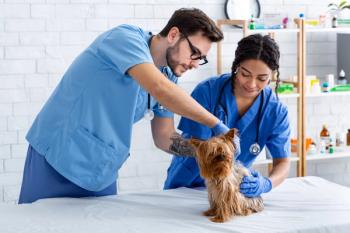
Attack veterinary clients' anesthesia fears
When clients hesitate to have their pet put under, be primed to pounce on their misconceptions, bat down myths about anesthesia, and strike back with facts and recommendations customized to their pet's condition.
"Surgery" is a scary word for clients, and when the veterinarian recommends a surgical procedure that requires anesthesia, it's all too common for clients to worry about their pet's safety. Striking back at their fears and reassuring clients can sometimes be more difficult than dealing with clients' financial woes. Although anesthesia seems ordinary to us, to a client it can be frightening.
I know the feeling. And you probably do, too. Anytime my pets have undergone dental procedures, the night before—and the day of the procedure—have been nerve-wracking. I know we have a great, competent team at our hospital and reliable, up-to-date monitoring equipment. I've seen my pets' preoperative blood work, but I'm still nervous.
Vetta/Getty Images
Now imagine being a pet owner who doesn't already have this knowledge of the team, monitoring equipment, and preoperative measures. It's no wonder they hesitate. Often we forget that our clients don't have this understanding of our precautions with anesthetic cases, and we may skim over the details in our discussions. Some clients may even postpone procedures time after time and never disclose that their real concern is fear of anesthesia because we never start the dialogue. We review the cost, the reasons for and the benefits of the procedure, and drop-off and pick-up times, but we all could probably improve our discussion about the safety of anesthesia.
Remember, these discussions can occur not just with the veterinarian, but also with credentialed technicians, assistants, and receptionists. Let's look at some common client questions about anesthesia and how to respond with reassurance.
1. How often do pets experience complications from anesthesia?
Although any anesthetic procedure has an element of risk, it's fairly uncommon. Studies have suggested that the risk of anesthetic death is about 1 in 2,000 for healthy, normal pets. For those pets that may have a pre-existing disease, the number increases to 1 in 500. To make this number stand out even more, remember that's a range of 0.05 percent to 0.2 percent—a very small percentage.
George Doyle/Getty Images
If your hospital possesses state-of-the-art monitoring equipment and a knowledgeable, continually learning team, don't be shy about touting this information to clients. Veterinary hospitals can vary greatly in their anesthetic care, so make sure your hospital stands apart from the rest and—at the very least—keeps team members educated on anesthetic procedures and complications. This may be a perfect time to explain to pet owners about the schooling and advanced training your licensed veterinary technicians undergo to be well versed in anesthesia.
Remember, to many pet owners, there's the doctor and then there's the rest of the team. They may feel reassured when they understand the doctor isn't the only trained medical professional on the team. If your hospital has a veterinary technician specialty (VTS) in anesthesia or surgery, mention this to clients.
2. I've heard that some people feel the pain of the procedure while under anesthesia. Could this happen to my pet?
Incorporating analgesics in your pre-, intra-, and postoperative protocol is important. Explain your protocol to clients. And assess patients' pain regularly using a consistent scale. Consider using CRIs for more painful procedures to maintain a constant, even level of pain management.
Assure clients that technicians know what to look for as far as signs of pain during the procedure—elevated respiratory and heart rates, for example—as well as after surgery. A pain-free patient is every staff member's top priority.
3. Do the benefits of surgery outweigh the risks of anesthesia?
This depends on the procedure. Many owners initially feel that a dental prophy is an elective procedure that will only restore teeth back to their original pearly white condition. They may not realize that without the dental procedure, bacteria from the mouth could spread into the bloodstream and affect the heart and kidneys. Also, a pet may suffer unnecessary pain from a dental condition, such as a fractured tooth with pulp exposure. For a mass removal where malignancy is a possibility, explain to the owner that surgical removal under anesthesia may help avoid metastasis as well as the cancer spreading locally. You can explain quality-of-life enhancing procedures, such as orthopedic surgeries, in terms of the very small percentage of anesthetic deaths versus the chance for a pet to live a higher-quality life with less pain. Of course there are some instances where anesthesia's risks are not worth proceeding, such as a 2 kg 18-year-old feline with a malignant mass, and it's important to respect the owner's decision and not be too forceful in these scenarios.
4. How is anesthesia administered?
Explaining your anesthetic protocol in great detail can comfort clients. When you explain the procedure with confidence and in a cohesive manner, it reflects the fact that these procedures are common in the hospital and the team is able and ready to handle any complications that may occur. Be sure to include your analgesic protocol as well, so clients understand that their pets will be as close to pain-free as possible during their stay. Don't forget to mention your hospital's monitoring equipment, recovery set up, and what the owner can expect at home afterwards.
5. Could my pet aspirate food while under the influence of anesthesia?
When you speak to pet owners, stress that when veterinarians make their recommendations, they want input and assistance from the pet owner as well. From weight-loss plans and medications to anesthetic procedures, we need client compliance to achieve the best care for our patients. Give a written to-do list before surgery, including instructions to withhold food, so the client feels comfortable, has a reference, and feels a bit more in control of their pet's care. You may also explain your technical procedures, such as using intubation with inflated tubes that seal the air passageways from regurgitation, to offer comfort and reassurance.
6. Who will monitor my pet during the procedure?
Explain that a credentialed technician will monitor the patient, along with the doctor. You may need to define what credentialed technicians are and explain their educational background.
7. Will a doctor be nearby to respond to an emergency, and do you have the proper equipment to respond?
From a legal standpoint, a doctor should be on the premises at all times during a procedure, and ideally, tending to the patient under anesthesia. Not only is the doctor nearby to communicate emergency drug orders and other requests, but a credentialed technician should monitor. This person must be able to confidently assess the patient and communicate concerns with the doctor. Remind the client that you have reversals and anticholinergics as well as other emergency drugs, and whatever equipment your hospital has available—tracheotomy, intraosseous catheters, defibrillator, ventilators, and so on—to respond in case of an emergency. Use the "Glossary of terms" at below to help explain these tools and procedures to clients. Providing cardiopulmonary cerebral resuscitation (CPCR) training to staff members—Red Cross has a specific animal program—can set your hospital apart from others.
Glossary of terms
8. Isn't my pet too old for anesthesia?
Remember, age is not a disease by itself. Yes, with age, other disease processes tend to come along, but a pet's age isn't usually a good enough reason to avoid a necessary procedure. Explain that with any patient, young or old, you will perform preoperative blood work to check the functioning of internal organs that have to process the anesthetics. Depending on those results, the doctor can reconsider the anesthesia risks and adjust the anesthetic protocol to help protect the patient from anesthetic disasters. In most hospitals, it's mandatory that all surgical patients have intravenous catheters and pre-, intra-, and postoperative intravenous fluids to help maintain blood pressure during anesthesia. Also, intravenous access guarantees an easy access port for emergency drugs if needed.
9. Can't we just give my pet an injectable anesthetic like I had for my wisdom teeth removal?
For most surgical procedures, with the exception of feline neuters, full anesthesia is necessary for the pet's safety and comfort level. The surgeon needs to be able to ensure that the patient is fully relaxed so that a procedure can be performed smoothly and with precision. More important, for many of these procedures, injectable anesthetics don't provide enough analgesia for the patient during the procedure. Although most practices use multimodal anesthesia, with a combination of injectable drugs and inhalants, neither can be used completely alone for advanced surgical procedures. It's always helpful to remind pet owners that if they were having that surgery, would they really want only an injectable anesthetic that is likely to wear off too soon?
Final thoughts
Client education is vital in a world with many easily accessible, and not always accurate, Internet resources for owners to turn to. Clients can get overly concerned after researching all the horror stories online of anesthesia gone wrong before even talking to you. When a client expresses concern over anesthesia, don't dismiss the concern. Instead ask what they're worried about. Provide statistics, and tout your hospital's educated, knowledgeable team. It may also be helpful to create an anesthesia FAQ for your hospital for clients considering a surgical procedure.
Remember that some clients may have concerns over safety but they pretend their worries are related to financial or scheduling concerns to avoid criticism. Be willing to include the client in the process and consider that the patient's family and the team all have one important common goal: the patient's well-being, safety, and a smooth anesthetic recovery.
Oriana D. Scislowicz, BS, LVT, is a technician in Richmond, Va. Share your thoughts at
Newsletter
From exam room tips to practice management insights, get trusted veterinary news delivered straight to your inbox—subscribe to dvm360.





